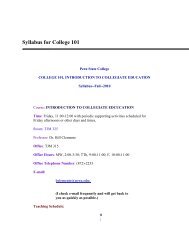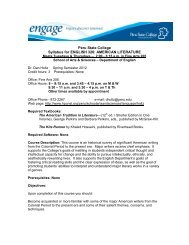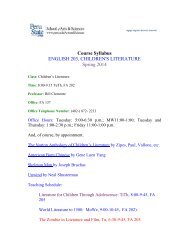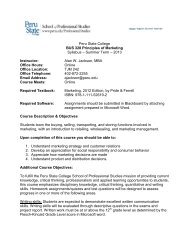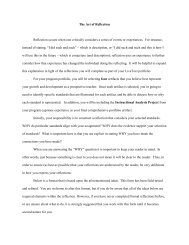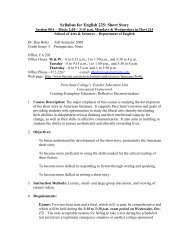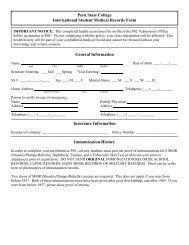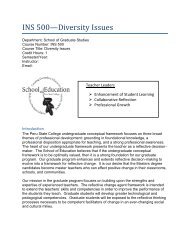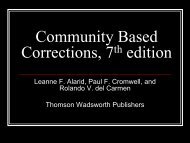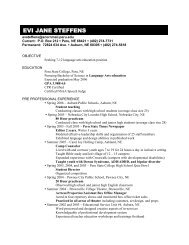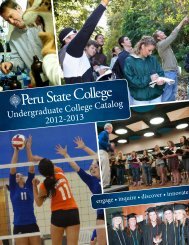315 Secondary Physical Education and Health Teaching Methods
315 Secondary Physical Education and Health Teaching Methods
315 Secondary Physical Education and Health Teaching Methods
You also want an ePaper? Increase the reach of your titles
YUMPU automatically turns print PDFs into web optimized ePapers that Google loves.
COURSE SYLLABUS HPER <strong>315</strong> – <strong>Secondary</strong> <strong>Physical</strong> <strong>Education</strong> <strong>and</strong> <strong>Health</strong> <strong>Teaching</strong> <strong>Methods</strong>School: <strong>Education</strong> Department: <strong>Health</strong> <strong>and</strong> <strong>Physical</strong> <strong>Education</strong> Course No. <strong>315</strong> 00A Credit Hours: 3Course Title: <strong>Secondary</strong> <strong>Physical</strong> <strong>Education</strong> <strong>and</strong> <strong>Health</strong> <strong>Teaching</strong> <strong>Methods</strong>Peru State College Mission StatementIn educating the individual to the benefit of society, Peru State College cultivates the capacity <strong>and</strong> propensityfor life-long learning by fostering independent inquiry <strong>and</strong> promoting the value of knowledge <strong>and</strong> discovery.Through innovative undergraduate <strong>and</strong> graduate programs, Nebraska's first college continues its commitmentto making a vital contribution to the future of the region <strong>and</strong> the state.Reflective Decision-Makers‣ Foundational Knowledge‣ Professional Dispositions & Integrity‣ Professional DevelopmentSchool of <strong>Education</strong> Mission Statement: The Teacher <strong>Education</strong> Unit is committed to preparing exemplaryprofessionals in the field of education. The faculty <strong>and</strong> staff of our teacher education unit underst<strong>and</strong> thecomplexity, interrelatedness <strong>and</strong> recursive nature of the teaching/learning process. We are committed topreparing our teacher education c<strong>and</strong>idates to be reflective professionals, knowledgeable in general studies,specific content areas, <strong>and</strong> pedagogy. In addition, we want their educational experiences to equip them to beeffective communicators <strong>and</strong> wise decision-makers in a democratic <strong>and</strong> increasingly technological society. Wealso want our graduates to appreciate diverse cultures <strong>and</strong> viewpoints. Therefore, we create <strong>and</strong> updatecourses based upon our study <strong>and</strong> reflection of current research <strong>and</strong> professional writing. We encouragediverse field experiences, co-curricular activities <strong>and</strong> professional opportunities. We believe that learning is alifelong process that involves continual growth in three broad conceptual areas: foundational knowledge,professional dispositions <strong>and</strong> integrity, <strong>and</strong> professional competencies.Peru State College’s commitment to individual attention <strong>and</strong> needs is evident in our teacher educationprogram. We also encourage our students to hone their passion for teaching <strong>and</strong> their unique talents throughintegrated community service opportunities related directly to their professional courses <strong>and</strong> activities. Ourfaculty <strong>and</strong> staff are committed to modeling that learning is an ongoing, challenging enterprise engaged in bycommitted persons – teachers, teacher c<strong>and</strong>idates, <strong>and</strong> community members together, all part of an exciting<strong>and</strong> rapidly changing world.Catalog Course Description: This course provides <strong>Physical</strong> <strong>Education</strong>/<strong>Health</strong> <strong>Education</strong> majors withopportunities to study, discuss, organize, <strong>and</strong> practice instructional methods specifically for middle <strong>and</strong> highschool <strong>Physical</strong> <strong>Education</strong> <strong>and</strong> <strong>Health</strong> students. Prerequisites: Admission to Teacher <strong>Education</strong> <strong>and</strong>concurrent enrollment in EDUC 309 or EDUC 312Required Text:Buck, M. M., Lund, J. L., Harrison, J. M., <strong>and</strong> Cook, C. B. )2007). Instructional strategies for secondaryphysical education, 6 th ed. Boston: McGraw-Hill.school
Course Objectives Upon successful completion of this course, the teacher c<strong>and</strong>idate will1. Develop goals for secondary physical education in line with state <strong>and</strong> national guidelines. (CF: 1.3.4, 2.1.1,3.1.1, 1.3.5, 1.3.6) [INTASC: 7C, 7D, 7E, 7F 7G, 7J] /AAHE:IB, IIIC\2. Identify the basic skills necessary for students grades 7-12 to develop motor skill competencies as definedby NASPE st<strong>and</strong>ards. (CF: 1.2.1, 1.2.2, 1.2.3, 1.3.2) [INTASC: 3A, 3D, 3K, 4C, 4I, 7G, 7J, 8B, 8D, 8F]3. Assess a wide variety of instructional methods which will engage the student <strong>and</strong> meet the diverse needsof today’s secondary population. (CF: 1.2.1, 1.2.2, 1.2.3, 1.3.2) [INTASC: 4A, 4B, 4C, 4F]< NASPE: 5.1, 5.2> /AAHE: IIID4. Demonstrate competency in utilizing a variety of technological tools to enhance instruction <strong>and</strong> learning.(CF: 1.3.4, 2.1.1, 3.1.1, 1.3.5, 1.3.6) [INTASC: 6M]< NASPE: 3.7> /AAHE: IVB5. Comprehend the role of a teacher as a reflective decision-maker with respect to teaching physicaleducation <strong>and</strong> <strong>Health</strong> in the secondary school. (CF: 1.2.1, 1.2.2, 1.2.3, 1.3.2) [INTASC: 9A, 9B, 9C, 9D, 9E, 9F,9G, 9I, 9J]< NASPE: 5.3> /AAHE: VIB6. Utilize a variety of assessment methods <strong>and</strong> tools in measuring student progress in physical education.(CF: 1.3.4, 2.1.1, 3.1.1, 1.3.5, 1.3.6) [INTASC: 8C, 8D, 8F, 8G]< NASPE: 5.1, 5.2> /AAHE: VD7. Demonstrate an underst<strong>and</strong>ing of being committed to all students <strong>and</strong> their learning. (CF: 1.3.4, 2.1.1,3.1.1, 1.3.5, 1.3.6) [INTASC: 3F, 7A, 7D, 7E, 7F, 7H, 7I]< NASPE: 6.1> /AAHE: IIIB8. Develop strategies for enhancing, managing, <strong>and</strong> monitoring student learning. (CF: 1.3.4, 2.1.1, 3.1.1,1.3.5, 1.3.6) [INTASC: 5B, 5C, 5E, 5G, 5H, 5I, 5J]< NASPE: 4.2, 4.4, 4.5, 4.6> /AAHE:IIID9. Demonstrate an underst<strong>and</strong>ing of underlying theories <strong>and</strong> rationale for instructional strategies, i.e.,multiple intelligences, learning styles, cooperative learning. (CF: 1.2.1, 1.2.2, 1.2.3, 1.3.2) [INTASC: 2A, 2B,2C, 2D, 3A, 3B, 3D, 3F]< NASPE: 1.1, 1.2> /AAHE: IIIB10. Identify <strong>and</strong> implement individualized strategies for special populations. (CF: 1.2.1, 1.2.2, 1.2.3, 1.3.2)[INTASC: 2A, 2B, 2C, 2D, 3A, 3B, 3D, 3F] /AAHE: IIID11. Design <strong>and</strong> present a competent plan for instruction in secondary physical education <strong>and</strong> health.(CF: 1.1.2, 1.2.2, 1.2.3, 1.3.2, 1.3.3, 1.3.5) [INTASC: 1D, 1F, 6I, 6L, 6M, 7A, 7B, 7C, 7D, 7E, 7F]< NASPE: 3.6, 4.2> /AAHE: IIIB, IIIC, IIID12. Design a curriculum map incorporating other content areas appropriate for secondary school students.(CF: 1.1.1, 1.2.1, 1.2.2, 1.3.3, 3.1.2) [INTASC: 1C, 1F, 7A, 7B, 7C, 7D, 7E, 7F]< NASPE:3.1, 3.2> /AAHE: IIIE13. Exhibit professional responsibility as evidenced by attending all class sessions, engaging in the learningprocess, collaborating with others, <strong>and</strong> meeting all deadlines. (CF-I: 2.1.1) [NASPE 6.2, 6.3]For coding purposes, CF refers to the Peru State College School of <strong>Education</strong> & Graduate Studies ConceptualFramework (Initial Level). INTASC refers to the Interstate New Teacher Assessment <strong>and</strong> Support ConsortiumSt<strong>and</strong>ards. NASPE refers to National Association for Sport <strong>and</strong> <strong>Physical</strong> <strong>Education</strong> (Initial level – 2008). AAHErefers to the American Association of <strong>Health</strong> <strong>Education</strong> St<strong>and</strong>ards (2008 NCATE <strong>Health</strong> <strong>Education</strong> TeacherPreparation St<strong>and</strong>ards).Student RequirementsIn addition to adhering to the policies of Peru State College students will be expected to:• Be in attendance <strong>and</strong> prepared to begin class at the scheduled time.2
• Complete all reading assignments prior to the class session for which each is assigned.• Purchase <strong>and</strong> maintain your own textbook.• Complete all assignments on time.• Most outside of class assignments will be formatted using word processing <strong>and</strong> will be electronicallysubmitted to the appropriate assignment link on Blackboard.• Description of assignments <strong>and</strong> expectations are outlined in this syllabus <strong>and</strong> will be discussedthroughout the semester.• Instruction Method/Mode of Delivery:1. Students are encouraged to seek assistance during the posted regular office hours or arrange anappointment by calling 402-872-2392 or emailing ekunkel@peru.edu.2. Class lectures, discussion, collaboration, literature research, presentations, program planning, <strong>and</strong>participation will be utilized for achieving the course objectives.3. Small group discussions will be conducted to establish similarities <strong>and</strong> differences frominformation <strong>and</strong> materials accumulated outside of class.4. Students will develop a unit plan.5. Students will produce a <strong>Methods</strong>/Strategies presentation based on current research regardingteaching methods.6. Alternate activities (recently recorded educational TV instructional videos, timely discussion ofmajor newsworthy topics, or other discoveries) may be utilized to allow for coverage of currentitems interest.7. A Final Exam will be given at the scheduled time.Assignment DescriptionsAssignment - Unit Plan in Alignment with Instructional Analysis Plan (100 Points)This requirement consists of the development of a unit plan in <strong>Secondary</strong> <strong>Physical</strong> <strong>Education</strong> that will bedesigned to parallel the Instructional Analysis Plan (IAP). The unit plan will consist of the following elements:To begin your Unit Plan, write an introductory statement that includes the following information:1. Name of class <strong>and</strong> grade level2. Student characteristicsA. demographicsB. ability levelsC. students with special needs3. Any other factors/characteristics associated with this classUse a class from your practicum experience as an example for this assignment.Elements of the Unit Plan1. Instructional Objectives - List the instructional objectives ("Learner will" statements) that will befocused upon for this unit.3
• Each objective is to be specific to the student learning you are focusing upon• Directly relate each objective to the content <strong>and</strong> instructional design being implemented within thisunit.• Objectives should be clearly stated, developmentally appropriate, <strong>and</strong> aligned to National Associationfor Sport <strong>and</strong> <strong>Physical</strong> <strong>Education</strong> (NASPE) St<strong>and</strong>ards <strong>and</strong> NHES National <strong>Health</strong> Ed St<strong>and</strong>ards (NHES)2. Unit Overview - Instructional Block Plan Grid - Complete the block plan format grid (located inBlackboard <strong>and</strong> LiveText– you may download for an electronic copy) to provide an overview of your entirelearning unit. This block plan includes:• The topic or activity you are planning for each day.• Instructional objective or objectives (coded from your Instructional Objectives section) you areaddressing in each activity.Note: Make certain that every instructional objective is addressed by at least one activity <strong>and</strong> thatevery activity relates to at least one instructional objective to indicate the direct connection ofinstructional objective to the instructional activities you have chosen for this unit.• Name of assessmentoShow alignment between activity & assessment by using a corresponding numbering system3. One Detailed Lesson Plan - Provide one detailed lesson plan from the unit that you believe stronglyimpacts student learning <strong>and</strong> reflects the required components of an effective lesson plan. Thesecomponents include, but are not limited to:• Overview: This should be a statement regarding what is to be taught <strong>and</strong> the importance of thisparticular lesson to the overall unit.• Instructional Objectives: Develop instructional outcomes for each lesson (there should be at least twoobjectives per lesson). Be sure your objectives include the cognitive, affective <strong>and</strong> psychomotordomains. Align your instructional objectives to National Association for Sport <strong>and</strong> <strong>Physical</strong> <strong>Education</strong>(NASPE) St<strong>and</strong>ards <strong>and</strong> NHES National <strong>Health</strong> Ed St<strong>and</strong>ards (NHES)• Materials: List <strong>and</strong>/or describe all materials needed. Provide numbers for all materials needed.• Class Description: Indicate class, content area <strong>and</strong> how the classroom will be arranged.• Diagram of Instructional Area• Outline Procedures of the Lesson:oIntroduction (Set) – Explain how you will lead into the lesson. A set provides focus <strong>and</strong> sparksinterest in the lesson.o Instruction – Outline/list how you plan to model <strong>and</strong> teach the skill to students. Use ofminimum of two different teaching strategies.• Label all strategies.• Align with st<strong>and</strong>ardso Practice – Outline/explain the activity you will use to allow the students to practice the skill.Include both guided <strong>and</strong> independent practice on the plan.o Diagram all formations, drills, student placement, equipment, etc.o Evaluation/Assessment Explain how you will determine whether theobjective(s) have been met.4
oAlign with objectives/st<strong>and</strong>ardso Closure – Indicate how you plan to end the lesson in a meaningful way.o Lesson summary - Provide an explanation for the lesson explaining why you are incorporatingthe lesson into your unit. In your explanation, include: Relation of activity/ies to your instructional objective(s) Rationale for including the instructional activity/ies within the larger unit4. Unit Summary – Write a narrative that includes the following elements:Differentiation of Instruction - Identify the extent to which you have included differentiation ofinstruction within this unit of instruction. What specific activities, strategies, etc. have youincorporated to ensure that instruction meets the needs of all students?Technology - Describe how you utilized technology in your planning, instruction <strong>and</strong> recordkeeping.Connection to Curriculum - Identify how this unit connects or integrates with the curriculum for thisgrade level <strong>and</strong>/or content area. Why is it an effective unit of instruction for this course?5. Unit Assessments - IO <strong>and</strong> Assessments Alignment GridConstruct a table (using blank IO & Assessments Alignment grid on Blackboard or LiveText) that lists:oooEach instructional objectiveAssessment(s) used to judge student performance relative to each objectiveAccommodations of the assessments for the individual needs of students based on contextualfactors of your cooperating school.The primary purpose of this table is to depict the alignment between instructional objectives <strong>and</strong>assessments. The table also provides opportunities to show where accommodations are going tobe implemented to meet the individual needs of students or contextual factors - you are expectedto include at least two accommodations that effectively differentiate learning for your students.6. References/St<strong>and</strong>ardsReference page should include all resources used (including st<strong>and</strong>ards).Give a brief description of the st<strong>and</strong>ards set used, including information on how to reference yourst<strong>and</strong>ards. You may list all st<strong>and</strong>ards (in full versus only code number) you are addressing in this section<strong>and</strong> provide information on how they are coded in the rest of your plan, or you may provide the full text ofeach st<strong>and</strong>ard in each lesson listed.Assignment – Checkpoints for IAP Unit Plan (point deductions, only)Throughout the semester, you will submit portions of your unit plan <strong>and</strong> meet individually (refer to dates oncalendar) with the instructor for feedback <strong>and</strong> revision information. Failure to submit the indicated portion ofyour plan <strong>and</strong> meet by the designated dates will result in a deduction of points from the final Unit Plan.Checkpoints <strong>and</strong> Deductions:#1 Introductory Statement, Block Plan Grid <strong>and</strong> Unit Objectives 25 point deduction#2 Lesson Plan: 25 point deduction#3 Assessment Grid <strong>and</strong> Unit Summary: 25 point deductionAssignment - Curriculum Mapping Project (50 points)This collaborative project will consist of the procedures for developing curriculum maps. Working as a“department” within your content area, you will work with fellow teacher c<strong>and</strong>idates to organize <strong>and</strong> align thecurriculum with each other as well as incorporating cross-curricular concepts with other “departments”.5
Assignment - Article Critiques (3 @ 50 points each = 150)Select an article from a professional journal that is current (within the last two years) <strong>and</strong> relevant to theassigned topic (to be determined by you):Write a brief summary of the main points of the article followed by a critique of the findings in the article. Thecritique should consist of your analysis of the information including, but not limited to, your agreement ordisagreement with the information <strong>and</strong> how you will use it in your own teaching. An oral presentation of eachcritique will be conducted during a designated class period (see course calendar for dates) in seminar format.There are two sections to this requirement:1. Written Critique (30 points)--Summarize the article (1/3 of paper = 10 points)--Discuss what you think of the topic (1/3 of paper = 10 points)--Discuss how the information can be applied to your own profession (1/3 of paper = 10 points )Paper is to be 1 – 2 pages in length, double-spaced with 1 inch margins. Begin your paper with the full citationof the article (use APA style). Papers without the full citation will not be given credit. Submit to theappropriate assignment link on Blackboard. Due date for submission of written paper is the date of yourpresentation in class.2. Presentation (20 points)In addition to the written critique, you will present your information to the class in a seminar format.--Summarize the article (1/4 th of presentation = 5 points)--Discuss what you think of the topic (1/4 th of presentation = 5 points)-- Discuss how the information can be applied to your own profession (1/2 of presentation =10 pt)Additional point deductions will result for any or all of the following: lack of preparation, poor presentationskills, lack of knowledge of the topic, poor eye contact, <strong>and</strong>/or lack of organization. No points will be awardedif the majority of the information is read to the class.NOTE: Critiques not presented in class will not receive credit.Assignment – Concept Applications (10 @ 10 points each = 100 points)Throughout the semester, you will have the opportunity to apply concepts learned in the course to teachingsituations. Most of these activities will be completed during class time, however, in the event time does notallow for completion, some work may be completed outside of class.Assignment - Instructional Technology Presentation (25 Points)Select a technological tool you will utilize in your teaching <strong>and</strong> present your information to the class.• Demonstrate use of this technological tool to the classo Actual use of the tool ORo Description with visual (website information, PowerPoint, etc.)o Example of how/when you will use this technological tool• Written requirements are submission of citation of sources used along with a short summary of yourmethod.Assignment – <strong>Health</strong> <strong>and</strong> <strong>Physical</strong> <strong>Education</strong> Integration Plan Presentation (25 Points)6
Select content area other than <strong>Health</strong> <strong>and</strong> <strong>Physical</strong> <strong>Education</strong>. Develop a plan to include this content area in anintegrated <strong>Health</strong> <strong>and</strong> <strong>Physical</strong> <strong>Education</strong> lesson. You will teach your lesson to the class. BE CREATIVE!!!BE CREATIVE AND HAVE FUN!!! Written requirements are submission of citation of sources used along witha short summary of your plan.Assignment – <strong>Methods</strong>/Strategies Presentation (50 points)• Prepare a Powerpoint presentation (8 – 10 minutes in length) describing your teaching methods<strong>and</strong>/or strategies. The presentation should contain, at a minimum, the following elements:ooooooIntroduction – Introduce methods/strategies• Discuss your philosophy of teaching• Introduce strategies you will incorporate• Cite statistics from the literature to support your methods/strategiesDescription of one of your lesson plans OR of the entire Unit OR a specific strategy or method• If describing a unit or lesson, focus on strategy used versus detailing the entire plan• If describing strategy or method, provide clear examples• How will you differentiate instruction• Learning Styles• Multiple Intelligences• Students with special needsDiscuss research that supports your methods/strategies (you may incorporate the informationobtained via your article critiques throughout the semester).Summary of your informationConclusion about what you believe about your instructional methods/strategiesReference slide – Include ALL references used (APA style)• Present your information as if you were conducting a workshop for other physical education <strong>and</strong>health teachers in a secondary school setting.o Slides should be easy to read, with enough information on each slide to depict the main point.• Avoid using long sentences/phrases (this allows you to talk about the informationversus reading the slides to your audience).• Talk to the audience, NOT the slides!• BE PREPARED• KNOW YOUR INFORMATION• Professional attire is required on the day you present your information.Remember to cite references on EACH slide that refers to any information from your source as well ascomplete citations on a reference slide at the end of your presentation.Final Examination (100 points) – A final examination will be administered during the scheduled Final Exam.7
Assessment <strong>Methods</strong>:Requirement Objective Point Value*Unit Plan* (aligned with IAP) 1,2 6 8 9,10,11,13 100Curriculum Mapping Project 1,2,5,8,12,13 50Article Critiques (3 @ 50 points each) 2, 3,5,13 150Concept Applications (10 @ 10 pt. ea.) 1-13 100Instructional Technology Presentation 3,4,13 25Grading Policy:A 600 - 540B+ 539 - 510B 509 - 480C+ 479 - 450C 449 – 420D+ 419 – 390D 389 – 360Integration Plan Presentation 3,8,10,11,13 25<strong>Methods</strong>/Strategies Presentation 1, 3, 4, 5 - 9,11,13 50Final Examination. 1 - 13 100TOTAL POINTS POSSIBLE FOR COURSE: 600*ATTENTION– LIVETEXT REQUIREMENT!!!The Unit Plan (IAP) is the required artifact for LiveText. This assignment must be submitted via the LiveTextCourse Link in order to receive credit for this course.Placement of this assignment in your Portfolio is not required.Requirements for Submission of Work:• Ten percent (10%) of the total possible points for an assignment will be deducted from the earnedgrade for each day an assignment is late. The instructor reserves the right to determine if there arespecial circumstances that allow for an extension of the deadline.• You must be in attendance to receive credit for in-class activities <strong>and</strong> assignments. If you will be absentfor a school sponsored event, you should complete the in-class assignment prior to the absence orwithin one class period after the absence.• You may NOT make up in-class presentations/requirements without PRIOR approval from theinstructor. If you are absent the day you are to present ANY of the assignments <strong>and</strong> have not madeprior arrangements, you will receive no credit for those presentations <strong>and</strong> will not be able to reschedule.The instructor reserves the right to determine if a requirement may be fulfilled at analternate time.• Any written work, including presentations, that is submitted without proper citation WILL NOT begiven credit as this is considered plagiarism.• ANY violation of the Academic Integrity Policy will result in FAILURE of this COURSE.• All assignments MUST be completed by the last regularly scheduled day of this course.8
Attendance Policy:• There will be a 10% deduction of the total possible points for the class for each absence that occursafter three absences from class. There are no excused or unexcused absences. Absence from class toparticipate in school sponsored events will count as 1 absence for the semester. The instructorreserves the right to review extenuating circumstances on a case by case basis.• Come to class on time <strong>and</strong> be prepared. Three tardies will equal one absence.• Students are expected to attend class regularly, to arrive punctually, <strong>and</strong> to complete all assignedwork. Attendance is a privilege <strong>and</strong> a responsibility represented by not only the student's investment,but also by a significant investment by the State of Nebraska.PLAGIARISM OF ANY TYPE WILL RESULT IN A ZERO FOR THE ASSIGNMENT AND POSSIBLE FAILURE OF THECOURSE. In order to promote academic integrity, the college subscribes to an electronic service to reviewpapers for the appropriate citations <strong>and</strong> originality. Key elements of submitted papers are stored electronicallyin a limited access database <strong>and</strong> thus become a permanent part of the material to which future submissionsare compared. Continued enrollment in a course signifies your permission for this use of your written work.Should you not wish to agree to this procedure, you may drop the course during the add/drop period beforeany works are completed <strong>and</strong> submitted.College’s Incomplete Coursework PolicyTo designate a student’s work in a course as incomplete at the end of a term, the instructor records theincomplete grade (I). Students may receive this grade only when serious illness, hardship, death in theimmediate family, or military service during the semester in which they are registered prevents them fromcompleting course requirements. In addition, to receive an incomplete, a student must have completedsubstantially all of the course’s major requirements.Unless extenuating circumstances dictate otherwise, students must initiate requests for an incomplete byfilling out an Incomplete Grade Completion Contract, which requires the signature of the student, instructor,<strong>and</strong> Dean. The Incomplete Grade Completion contract cites the reason(s) for the incomplete <strong>and</strong> details thespecific obligations the student must meet to change the incomplete to a letter grade. The date by which thestudent agrees to complete required work must appear in the contract. The Dean, the instructor, <strong>and</strong> thestudent receive signed copies of the Incomplete Grade Completion Contract.Even if the student does not attend Peru State College, all incomplete course work must be finished by the endof the subsequent semester. Unless the appropriate Dean approves an extension <strong>and</strong> if the student does notfulfill contract obligations in the allotted time, the incomplete grade automatically becomes an F.Policy on Academic IntegrityThe College expects all students to conduct themselves in a manner that supports an honestassessment of student learning outcomes <strong>and</strong> the assignment of grades that appropriately reflectstudent performance. It is ultimately the student’s responsibility to underst<strong>and</strong> <strong>and</strong> comply withinstructions regarding the completion of assignments, exams, <strong>and</strong> other academic activities. At aminimum, students should assume that at each assessment opportunity they are expected to dotheir own original academic work <strong>and</strong>/or clearly acknowledge in an appropriate fashion theintellectual work of others, when such contributions are allowed. Students helping others tocircumvent honest assessments of learning outcomes, or who fail to report instances of academicdishonesty, are also subject to the sanctions defined in this policy.Instances of academic dishonesty may be discovered in a variety of ways. Faculty members who9
assign written work ordinarily check citations for accuracy, run data base <strong>and</strong> online checks, <strong>and</strong>/ormay simply recognize familiar passages that are not cited. They may observe students in the act ofcheating or may become aware of instances of cheating from the statements of others. All personswho observe or otherwise know about instances of cheating are expected to report such instancesto the proper instructor or Dean.In order to promote academic integrity, the College subscribes to an electronic service to reviewpapers for the appropriate citations <strong>and</strong> originality. Key elements of submitted papers are storedelectronically in a limited access database <strong>and</strong> thus become a permanent part of the material towhich future submissions are compared. Submission of an application <strong>and</strong> continued enrollmentsignifies your permission for this use of your written work.NSCS Board of Trustees Policy 4220 states that each College “. . . will establish a distance learningassessment policy that will include, at a minimum, a substantial culminating experience that isproctored.” Peru State College’s policy is that each course that is offered entirely online will feature aproctored final exam that substantially measures the extent the course’s stated learning objectives areachieved. Courses which feature graded site-based activities (e.g., teaching demonstrations) <strong>and</strong>/orvideo-taped presentations that occur near the end of the term, <strong>and</strong> that are designed to substantiallyassess the achievement of learning objectives, can be considered in compliance with this policy.Project-based capstone <strong>and</strong> graduate courses utilizing real-time discussions held by web-cam, phoneor in person with the faculty member as part of the assessment process can also be considered incompliance with this policy.Should an occurrence of academic misconduct occur, the faculty member may assign a failing grade forthe assignment or a failing grade for the course. Each incident of academic misconduct should bereported to the Dean <strong>and</strong> the Vice President for Academic Affairs (VPAA). The VPAA may suspendstudents for two semesters found to be responsible for multiple instances of academic dishonesty.The reason for the suspension will be noted on the student’s transcript.A faculty member need present only basic evidence of academic dishonesty. There is no requirementfor proof of intent. Students are responsible for underst<strong>and</strong>ing these tenets of academic honesty <strong>and</strong>integrity. Students may appeal penalties for academic dishonesty using the process established forgrades appeals.First Recommended by Faculty Senate – September 3, 2009First Approved by Administration – September 8, 2009Revision Recommended by Faculty Senate – December 7, 2010Revision Approved by Administration – December 10, 2010Title IX Compliance NoticePeru State College is an equal opportunity institution. PSC does not discriminate against any student,employee or applicant on the basis of race, color, national origin, sex, disability, religion, or age in employment<strong>and</strong> education opportunities, including but not limited to admission decisions. The College has designated anindividual to coordinate the College’s nondiscrimination efforts to comply with regulations implementing TitleVI, VII, IX, <strong>and</strong> Section 504. Inquiries regarding non-discrimination policies <strong>and</strong> practices may be directed toEul<strong>and</strong>a Cade, Director of Human Resources, Title VI, VII, IX Compliance Coordinator, Peru State College, POBox 10, Peru, NE 68421-0010, (402) 872-2230.Students requesting reasonable accommodation <strong>and</strong> tutoring services should contact the Center forAchievement <strong>and</strong> Transition Services (CATS).10




